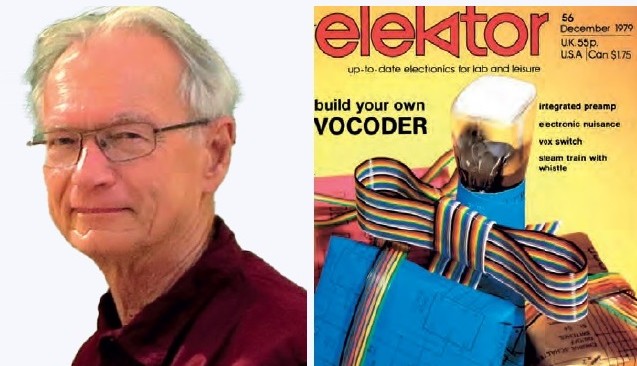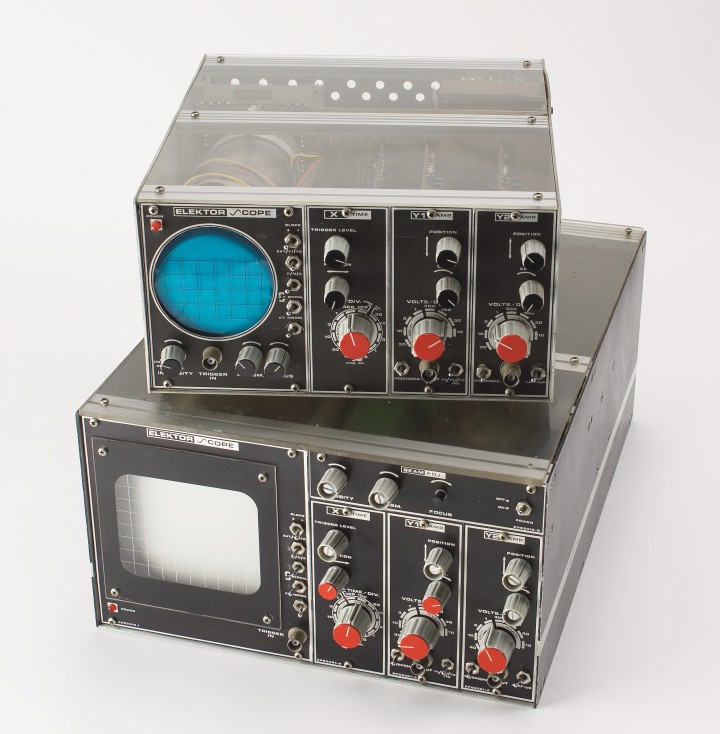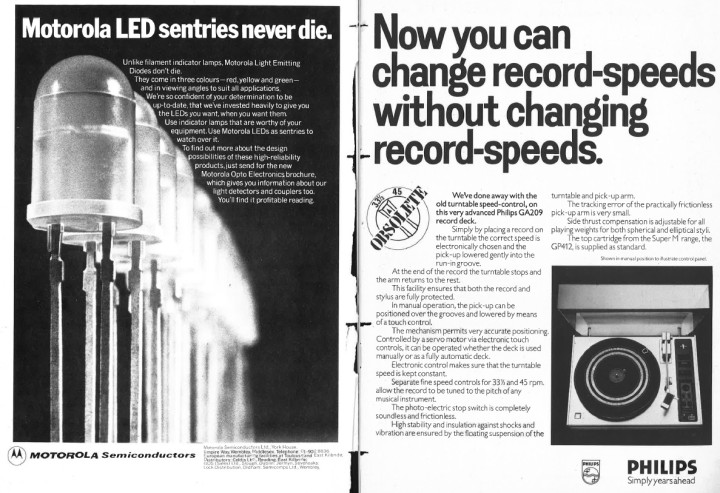Elektor in the 1970s and Beyond: A Q&A with Karel Walraven
on

Karel Walraven has experienced more than half of Elektuur's life years as designer, chief laboratory officer, and (chief) editor of our magazine. Before he started working for the then-called Uitgeversmaatschappij Elektuur — at the time still under the management of its founder Bob van der Horst — he had been a subscriber for many years. He owed much of his electronics knowledge to self-study, including building projects from our magazine. Here he offers some reflections about the years he worked with us.
Early Elektor
Lemmens: How did you start working for Elektor, and what positions did you hold?
Walraven: When I finished my Polytechnic electronics studies, there weren't too many jobs I was interested in. I had been a subscriber to Elektuur (as Elektor was called in the Netherlands) since I was 15 or so, but the idea of applying for a job there had never occurred to me, until at the job centre they casually mentioned that Elektor could always use people. So, I applied for a job, and to my surprise, they gave me a lot of homework. I was asked to translate and edit it, and above all to write down how long it had taken me to do so. And so began my adventure at Elektor on 1 January 1975 as a designer, editor and translator. I was thrown in at the deep end with the first project I had to set up myself: an oscilloscope was to be made. An experienced German author was supposed to take care of the design, but we sent him away after a week because his schematic turned out to be stolen and incomplete. It turned out to be a nice project after all, one of the first in which the housing was part of the design from the start.

A few years later, I became head of the lab, a position I held until my early retirement in 2006. For several years, I was also the general coordinating editor responsible for both the lab and the editorial staff.
Lemmens: Each edition of Elektuur required new projects. Where did the ideas come from?
Walraven: First of all, as a designer or editor, you have to be curious by nature. You read the publications of manufacturers and the magazines of your competitors. Then, of course, you have contact with your colleagues and, last but not least, with the readers. They come up with a lot of ideas, sometimes in the form of just a suggestion, often as a ready-made project. You absorb all that information, and for me, usually as soon as I wake up in the morning, I think "this is how I'm going to solve this" or "if I were to design that..."
Lemmens: Looking at the publications in Elektuur/Elektor from the very beginning until today, I would think that there have been clear trends in hobby electronics. For instance, in the 60s and 70s, there was great interest in audio projects. In the early 1980s, we saw the emergence of microcontrollers, home computers and PCs, and so on.
Walraven: Indeed, the audio projects in which we sometimes published an amplifier every year gave us a large audience. When the price of TTL ICs dropped below 1 guilder, Elektuur devoted almost a whole issue to the 7401.
The transition to the first microprocessor circuits was difficult. We felt it was an important development, but nobody had any idea what to do with it. We never really got beyond development systems, of which Junior is the best known. But there were more successful projects in this area, such as a series of 8051 boards, including the Basic Matchbox and the 8052-BASIC Compuboard. The accompanying software courses also attracted a great deal of interest from our readers.
Lemmens: Quite simply put, many of today’s hobby projects involve combining ready-made modules from the Far East, some software and possibly a 3D-printed enclosure to make it look neat. A lot has changed over the years, it seems to me.
Walraven: That’s right. In the 1950s, the AMROH company was dominant among home builders here in the Netherlands. That was actually a transformer factory, but to boost turnover, they sold building plans of amplifiers and radios for a few guilders, in which, of course, their transformers were used. Philips had complete kits with all the components, including step-by-step manuals in which every component and every wire was mentioned and what you had to do with it. Incredible quality, and of course, I built some of those too.
Elektor did not have all that. They did have the building plans, but otherwise, you had to figure it out yourself. And that all changed with the advent of the printed circuit board. Elektor started to print layouts that could be used to etch your own board. And a bit later, you could order ready-made PCBs from Elektor.
And the latter was a game changer. At first, the readers were looking forward to a difficult job, but now it all seemed so easy. From one day to another, Elektor sold tens of thousands of PCBs of its amplifier designs. (I am only talking about the Netherlands.) And the number of subscribers increased proportionally. All of a sudden, everyone started working with electronics. In those days, amplifiers still cost well over a thousand guilders, and homebrew was half the price.
Later, the software service was added. We sold cassette tapes and even singles with programmes, before the arrival of floppy disks, CDs and DVDs. Elektuur also sold (E)PROMs, programmed microcontrollers and programmable logic. Especially in the early years, the special programmers needed for this were far too expensive for the average hobbyist. With this service, we also made the related projects available to a much larger audience.
For the editors, this was a great success, but everything has its downside. Where previously readers knew quite a bit about electronics, a “consumer” audience came along that was not hindered by any knowledge and simply wanted value for money.
That was suddenly a completely different playing field. Many new subscribers, but also very different subscribers with different demands. Elektuur got the reputation that it was a really nice magazine, but that the schematics were unreliable. We never succeeded in shaking off that image completely, even though we built every circuit in the lab, had a question time and faithfully published all our failures.

Lemmens: Complete kits seem a logical next step, but still it took Elektuur a long time before it started selling them.
Walraven: Also, in those years, we earned our money by selling advertisements. Many of these advertisers sold components and (Elektor) kits themselves. From a commercial point of view, it was therefore not a good idea to get into their way. Moreover, Elektor became part of a large publishing company that saw nothing in other products than printed pages, and the sale of PCBs and software was already “not done.”
Lemmens: For a few years, the magazine Elex was the little sister of Elektuur in the Netherlands and France. In Germany, it was published for a while under the title ESM. It was a magazine for beginners that certainly attracted readers, but in the end proved not to be viable.
Walraven: Elex/ESM was quite popular, and as editors we enjoyed doing it, but we could not make any money with it because no advertiser was interested. The original plan was to make Elex with only one editor and republish the content every three years. But after the first issue, this was no longer the case and Elex relied on the work of the Elektor editors. Advertisers, especially parts shops, found the circuits in Elektor too large and complex, but the simpler designs in Elex were apparently not what they wanted either.

Technical Interests
Lemmens: I always had the idea that you were a jack-of-all-trades in electronics. Is that true, or were you very good at camouflaging the fact that you had no knowledge of some disciplines?
Walraven: I can talk about a lot of things. I know a bit about a lot of subjects. So yes, by and large I can follow what is happening left and right. Moreover, I can't stand not knowing something, so I look it up and the next time I know it. All my life, I have been fascinated by how things and processes work. By this I don't just mean technology, but certainly also the interaction between people. Incidentally, I have no problem at all coming forward when I don't know something.
Lemmens: Are you still working on electronics? If so, in what field?
Walraven: Not really. I occasionally work with model trains and use the BIDIB (DCC) boards for that. At the moment I design the mechanism to control my points and print that with my 3D printer. I also have some electronics with an Arduino Nano. Furthermore, I have made some smaller things like a thermometer with large display, thermostat, control for the extractor hood and similar devices. All with Arduino.
Lemmens: You have been retired for about 15 years now. Do you still miss Elektor?
Walraven: Unfortunately (for Elektor) I have to say that as a pensioner I am having the best time of my life. I am still healthy and free to do what I want. I work as a volunteer for the Community College and have built up a whole new circle of friends. I occasionally check out Elektor because I'm still interested in how the magazine is doing, but for me the content is too much focused on ever more powerful microprocessor boards these days. I don't subscribe to any magazine, not even a newspaper. The Internet is my window to the world.
Luc Lemmens is an engineer and technical editor at Elektor. You can read many of his articles at www.elektormagazine.com, and you can follow him on Twitter at https://twitter.com/LElektor.


Discussion (5 comments)